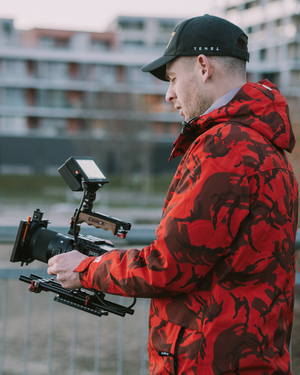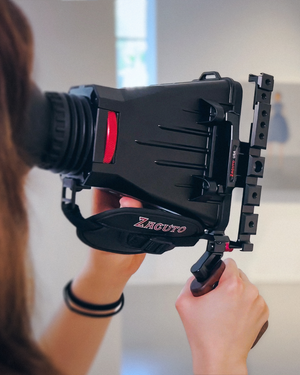
4 Lessons from a Film Set
So, we’ve reached the end of our Art Direction series journey. I’d like to leave you all with my thoughts on what may seem like unlikely priorities in today’s gear driven industry. I’ve spent a lot of time on film sets, both as a crew member and also an observer, and have come to several realizations that I hope provide some insight into what matters most.
Here are my 4 lessons from a film set.
 But, there’s so much more to learn! I’m certainly not saying everyone should go to Film School, far from it. However, there are fundamentals in this craft, that we often take for granted, that can only be passed down through an establishment steeped in tradition. It is vital that the more experienced generation of directors and cinematographers pass down these lessons to the next generation. And it is equally important that we are all open to hearing them.
But, there’s so much more to learn! I’m certainly not saying everyone should go to Film School, far from it. However, there are fundamentals in this craft, that we often take for granted, that can only be passed down through an establishment steeped in tradition. It is vital that the more experienced generation of directors and cinematographers pass down these lessons to the next generation. And it is equally important that we are all open to hearing them.
 But, the real deal here is to make sure you budget for Set Design, Art Direction, and to employ a Gaffer to manage your lighting. As I’ve stated in previous articles, Art Direction and Production Design are invaluable visual resources. Even John Seale ASC ACS himself mentioned the importance of using multi cameras only if your sets are "beautiful enough" to shoot, but first you must understand how that “world” is created.
But, the real deal here is to make sure you budget for Set Design, Art Direction, and to employ a Gaffer to manage your lighting. As I’ve stated in previous articles, Art Direction and Production Design are invaluable visual resources. Even John Seale ASC ACS himself mentioned the importance of using multi cameras only if your sets are "beautiful enough" to shoot, but first you must understand how that “world” is created.

 The Assistant Director is the unsung hero to the Director, the Gaffer to the DP, the Art Director to the Production Designer, the Boom Swinger to the Sound Recordist, and the Grip guys to the entire camera department…you get my drift.
My point? It’s not about you, it’s the collective.
*****
Read the rest of the series!
Read Part 1 here: Introduction
Read Part 2 here: What is Art Direction?
Read part 3 here: 3 Art Direction Tips for Productions on a Budget
Read Part 4 here: Graphic Novel Inspiration: Frank Miller and Zack Snyder
Read Part 5 here: Lessons from a Master – John Seale, ASC ACS
The Assistant Director is the unsung hero to the Director, the Gaffer to the DP, the Art Director to the Production Designer, the Boom Swinger to the Sound Recordist, and the Grip guys to the entire camera department…you get my drift.
My point? It’s not about you, it’s the collective.
*****
Read the rest of the series!
Read Part 1 here: Introduction
Read Part 2 here: What is Art Direction?
Read part 3 here: 3 Art Direction Tips for Productions on a Budget
Read Part 4 here: Graphic Novel Inspiration: Frank Miller and Zack Snyder
Read Part 5 here: Lessons from a Master – John Seale, ASC ACS

1. Learning Is Infinite And Perpetual
With the abundance and accessibility of modern camera technology, anyone can pick up a camera and create content. While this is an incredibly liberating time, I fear the finer aspects of honing ones craft are getting lost. "Low light" has become an overused buzz word, and “resolution” seems to be the only thing that matters. With so many young and incredibly talented filmmakers emerging these days, film school, etiquette, and working your way through the system is less relevant than it used to be. The internet is packed with tutorials available to anyone with a few clicks of a mouse. But, there’s so much more to learn! I’m certainly not saying everyone should go to Film School, far from it. However, there are fundamentals in this craft, that we often take for granted, that can only be passed down through an establishment steeped in tradition. It is vital that the more experienced generation of directors and cinematographers pass down these lessons to the next generation. And it is equally important that we are all open to hearing them.
But, there’s so much more to learn! I’m certainly not saying everyone should go to Film School, far from it. However, there are fundamentals in this craft, that we often take for granted, that can only be passed down through an establishment steeped in tradition. It is vital that the more experienced generation of directors and cinematographers pass down these lessons to the next generation. And it is equally important that we are all open to hearing them.
2. Spend Your Budget Wisely
For many aspiring directors, DPs, and filmmakers, the biggest line on a film’s budget may as well say...Gear Lust! Even on smaller projects, there is always the temptation to splurge on the newest camera with the highest resolution, often at the expense of more intangible things like Art Direction. The general argument is that clients are impressionable and will be more likely to hire you if you rocked up with a hundred thousand dollar camera. Unfortunately in most cases, they don’t know any better. That is why they employ you in the first place. For arguments sake, consider this...instead of getting one expensive camera, spend your camera budget on 2 or 3 (I know, please bear with me) older, more affordable cameras that will give a reasonable resolution and a very robust codec. There are plenty on the market if you take the time to look. Two or more cameras enables you to get maximum coverage, reverse angles, capture moments when actors ad-lib, assign more camera positions, and provide you with a backup. But, the real deal here is to make sure you budget for Set Design, Art Direction, and to employ a Gaffer to manage your lighting. As I’ve stated in previous articles, Art Direction and Production Design are invaluable visual resources. Even John Seale ASC ACS himself mentioned the importance of using multi cameras only if your sets are "beautiful enough" to shoot, but first you must understand how that “world” is created.
But, the real deal here is to make sure you budget for Set Design, Art Direction, and to employ a Gaffer to manage your lighting. As I’ve stated in previous articles, Art Direction and Production Design are invaluable visual resources. Even John Seale ASC ACS himself mentioned the importance of using multi cameras only if your sets are "beautiful enough" to shoot, but first you must understand how that “world” is created.
3. A Tool Is Only As Good As The Person Using It
As I mentioned before, the experiences I’ve had on set have been very revealing. On almost all of them, the Assistant Directors, Camera Assistants, Gaffers, Grips, Production Designers, and Art Directors do a majority of the heavy lifting. They are the ones that strengthen the brilliance of a gifted Director and a gun slinging DP. Select these individuals carefully, show them and their role in the production respect, and you’ll have a set that runs like clockwork.
4. There Is No “I” In Team
It baffles me how a lot of creative types take major credit for what is often only a minor role in a films creation. Or at the very least a role that was supported by many others. Never forget, behind every great filmmaker is a whole lot of crew and a litany of people organizing logistics, vehicles, props, routines, and so much more. There is a difference between a Director of Photography and one of many camera operators, but they both serve to achieve a universal outcome. Often the DP takes all the credit, and many times I’ve heard an Operator say he was one of many “Cinematographers”. The Assistant Director is the unsung hero to the Director, the Gaffer to the DP, the Art Director to the Production Designer, the Boom Swinger to the Sound Recordist, and the Grip guys to the entire camera department…you get my drift.
My point? It’s not about you, it’s the collective.
*****
Read the rest of the series!
Read Part 1 here: Introduction
Read Part 2 here: What is Art Direction?
Read part 3 here: 3 Art Direction Tips for Productions on a Budget
Read Part 4 here: Graphic Novel Inspiration: Frank Miller and Zack Snyder
Read Part 5 here: Lessons from a Master – John Seale, ASC ACS
The Assistant Director is the unsung hero to the Director, the Gaffer to the DP, the Art Director to the Production Designer, the Boom Swinger to the Sound Recordist, and the Grip guys to the entire camera department…you get my drift.
My point? It’s not about you, it’s the collective.
*****
Read the rest of the series!
Read Part 1 here: Introduction
Read Part 2 here: What is Art Direction?
Read part 3 here: 3 Art Direction Tips for Productions on a Budget
Read Part 4 here: Graphic Novel Inspiration: Frank Miller and Zack Snyder
Read Part 5 here: Lessons from a Master – John Seale, ASC ACS



Leave a comment